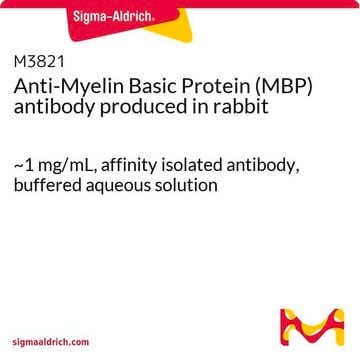AB5864
Anti-Myelin Basic Protein Antibody
serum, Chemicon®
Synonym(s):
MBP
Sign Into View Organizational & Contract Pricing
All Photos(2)
About This Item
UNSPSC Code:
12352203
eCl@ss:
32160702
NACRES:
NA.41
Recommended Products
biological source
rabbit
Quality Level
antibody form
serum
antibody product type
primary antibodies
clone
polyclonal
species reactivity
human, rat
manufacturer/tradename
Chemicon®
technique(s)
immunohistochemistry: suitable
NCBI accession no.
UniProt accession no.
shipped in
dry ice
target post-translational modification
unmodified
Gene Information
human ... MBP(4155)
rat ... Mbp(24547)
Specificity
Recognizes Myelin Basic Protein in demyelinated nerve tissues. Immunohistochemistry analysis of lesioned rat spinal cord shows a high level of specificity for this antiserum.
Immunogen
Synthetic peptide corresponding to amino acids 69-86 of the guinea pig protein. Immunogen corresponds to "degraded" Myelin Basic Protein: YGSLPQKSQRSQDENPVV
Application
Anti-Myelin Basic Protein Antibody is an antibody against Myelin Basic Protein for use in IH.
Immunohistochemistry: 1:2,000. Immunostains myelin basic protein of abnormal appearing oligodendrocytic processes and cell bodies in demyelinating areas. The antibody recognizes only areas of myelin degeneration when tested in injured spinal cord and lesioned sciatic nerve. It also stains discrete white matter in brain of multiple system atrophy
Optimal working dilutions must be determined by the end user.
Optimal working dilutions must be determined by the end user.
Research Category
Neuroscience
Neuroscience
Research Sub Category
Neuronal & Glial Markers
Neurodegenerative Diseases
Neuronal & Glial Markers
Neurodegenerative Diseases
Physical form
Rabbit Serum. Lyophilized, no preservatives. Reconstitute with 50 μL of sterile distilled water. Centrifuge to remove any residue.
Unpurified
Storage and Stability
Maintain at -20 to -70°C in undiluted aliquots for up to 12 months after date of receipt. Avoid repeated freeze/thaw cycles. Glycerol (1:1) can be added for additional stability.
Analysis Note
Control
Brain tissue
Brain tissue
Other Notes
Concentration: Please refer to the Certificate of Analysis for the lot-specific concentration.
Legal Information
CHEMICON is a registered trademark of Merck KGaA, Darmstadt, Germany
Disclaimer
Unless otherwise stated in our catalog or other company documentation accompanying the product(s), our products are intended for research use only and are not to be used for any other purpose, which includes but is not limited to, unauthorized commercial uses, in vitro diagnostic uses, ex vivo or in vivo therapeutic uses or any type of consumption or application to humans or animals.
Not finding the right product?
Try our Product Selector Tool.
Storage Class Code
11 - Combustible Solids
WGK
WGK 3
Flash Point(F)
Not applicable
Flash Point(C)
Not applicable
Certificates of Analysis (COA)
Search for Certificates of Analysis (COA) by entering the products Lot/Batch Number. Lot and Batch Numbers can be found on a product’s label following the words ‘Lot’ or ‘Batch’.
Already Own This Product?
Find documentation for the products that you have recently purchased in the Document Library.
Customers Also Viewed
Brian D Clark et al.
Journal of neurotrauma, 20(7), 681-695 (2003-08-12)
Anatomical and physiological changes were evaluated in the median nerves of rats trained to perform repetitive reaching. Motor degradation was evident after 4 weeks. ED1-immunoreactive macrophages were seen in the transcarpal region of the median nerve of both forelimbs by
Role of myelin auto-antigens in pain: a female connection.
Veronica I Shubayev et al.
Neural regeneration research, 11(6), 890-891 (2016-08-03)
Simon Ngamli Fewou et al.
Glycobiology, 29(9), 657-668 (2019-05-31)
A large body of the literature has demonstrated that the polysialic acid (polySia) modification of the neural cell adhesion molecule (NCAM) is a key regulator of cellular interactions during brain development, maintenance and plasticity. To properly fulfill these functions, polySia
Andriy O Glushakov et al.
International journal of molecular sciences, 19(10) (2018-10-17)
Traumatic brain injury (TBI) is associated with long-term disabilities and devastating chronic neurological complications including problems with cognition, motor function, sensory processing, as well as behavioral deficits and mental health problems such as anxiety, depression, personality change and social unsuitability.
Yun Ju C Song et al.
The American journal of pathology, 171(4), 1291-1303 (2007-09-08)
p25alpha is an oligodendroglial protein that can induce aggregation of alpha-synuclein and accumulates in oligodendroglial cell bodies containing fibrillized alpha-synuclein in the neurodegenerative disease multiple system atrophy (MSA). We demonstrate biochemically that p25alpha is a constituent of myelin and a
Our team of scientists has experience in all areas of research including Life Science, Material Science, Chemical Synthesis, Chromatography, Analytical and many others.
Contact Technical Service









